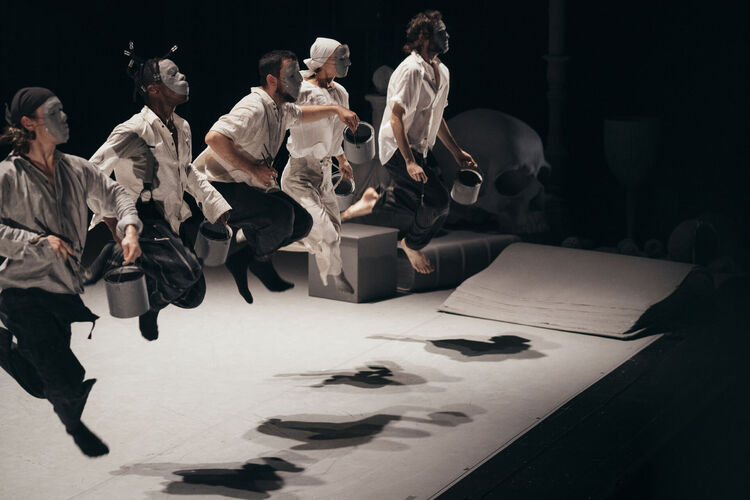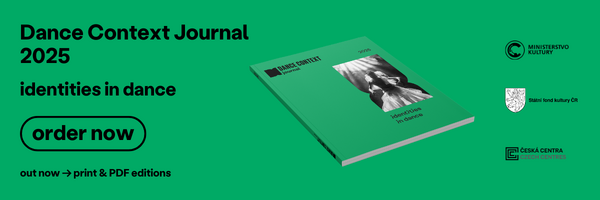The performance, which lasts 100 minutes, is not easy to decipher; it is a multilayered work full of meanings, references, and allusions. At first glance, its structure may appear random. Comic moments alternate with serious ones that wipe the smiles off the audience's faces. Specific geopolitical references are interwoven with more general, abstract parts that primarily target the audience’s emotional state. Likewise, in a constant cycle, songs and instrumental music curated by Floris De Rycker intertwine with Cherkaoui’s choreographic and theatrical scenes and striking scenographic elements in dark gray tones by Hans Op de Beeck. The stage design captures attention from the moment the curtain rises, revealing a large-scale structure resembling the upper part of a house with a charming, melancholicaly romantic tower. The space is enriched by countless details—a large white book, an oversized skull, a tall Greek vase, and a slender, elongated candlestick—all subtly permeated by the scent of incense.
Cherkaoui in Vlaemsch (chez moi) searches for home in words and memories, while the dance quietly supports the story
The season finale in the Spanish capital belongs to the Madrid en Danza festival, where some of the most prominent names on the contemporary dance scene can regularly be seen. One of them was the EASTMAN company of Belgian choreographer Sidi Larbi Cherkaoui, who presented his 2022 work Vlaemsch (chez moi). Cherkaoui is known for his creative interculturalism, which is wowen into not only his professional work but also his personal life. In this particular piece, he explores his Flemish roots on his mother’s side.
It wasn’t until I left the theater that I realized the structure of Vlaemsch (chez moi) only appears random and chaotic at first glance; in reality, it is a carefully constructed system with an internal logic that speaks directly to the central topic of the piece. Cherkaoui scrutinizes Flemish identity and challenges the obsessive notion of racial purity—any kind, without exception. Our histories, both personal and national, are sequences of events unfolding in rich and diverse contexts, not in a cultural vacuum. The author makes it clear that a “disinfected culture,” one free of external influences, is nothing more than a utopia. Cherkaoui is so forceful in his message that the very pursuit of purity may come across as absurd and banal to some.
Presenting such a work at a time when right-wing extremism is on the rise in both Europe and the wider world can be seen as a bold curatorial choice by the festival. Even in the context of Spanish politics, which may initially seem open and welcoming to outside influences under a left-wing coalition government, this selection could prove risky. Although the left currently holds power, the most recent elections were won by the conservative Partido Popular (led by Alberto Núñez Feijóo), which, despite support from the far-right Vox party (headed by Santiago Abascal), failed to form a government. This makes Cherkaoui’s work hit a particularly sensitive nerve, as it tackles a theme that resonates powerfully across Spanish society. It’s hard to say whether this was the reason why about ten audience members left the theater during the Madrid performance…
 by Sidi Labi Cherkaoui @ Eastman Company_62.jpg)
Cherkaoui evokes the ideal of cultural openness through a variety of topics. Feminist references arise during a guided tour of Flanders, drawing attention to the submissive position of women as reflected in local statuary. The LGBTQAI+ identity is made explicit through a massive pride flag waved by a performer at center stage, but also addressed with more nuance through the presence of a trans character with an American accent. Though she appears confident and assured throughout, a single hateful comment from a cisgender heterosexual man drives her to a suicide attempt. It’s a powerful moment, highlighting a painfully current issue—especially considering figures like American president Donald Trump and Pope Leo XII, both American, both known for their hostile stance toward this community. Cherkaoui also engages directly with questions of national oppression. At one point, a dancer shouts loudly: “Slava Ukraini!”—“Glory to Ukraine!” It’s a clear and intentional gesture that resonates sharply in today’s political climate.
Although the work is undoubtedly political, Cherkaoui never loses sight of his choreographic vision. His movement language is marked by fluidity and extension—waves rippling through the dancers’ bodies, bending and breaking just before reaching the other side. He favors an aesthetically pleasing vocabulary of expressive poses and spacious, captivating variations. Yet he doesn’t shy away from exploring more fractured, collapsing, or aggressive movements either. At times, the body becomes a canvas for intercultural symbolism—for instance, when a dancer in a loincloth spreads his arms in a striking evocation of the suffering Christ.
 by Sidi Labi Cherkaoui @ Eastman Company_24.jpg)
While Cherkaoui’s choreography overflows with movement rich in meaning, the spoken word remains primary narrative vehicle in Vlaemsch (chez moi). It is employed extensively throughout the piece. The directness of language strikes the audience not only through live speech but also via the lyrics of songs, whose translations are provided in advance by the creative team. Most of these texts are in Flemish, though they are occasionally interspersed with English parts and the performers’ native tongues. Together, they weave various personal stories tied to the search for cultural and personal identity—often through a return to ancestral roots, family memory, and language as a carrier of history. As a result, the notion of "home" in this work isn’t defined by a physical place, but by the spaces of thought, emotion, relationship, and language.
 by Sidi Labi Cherkaoui @ Eastman Company_56.jpg)
That said, I found myself wishing that the power of speech and acting didn’t come at the expense of the choreographic structure and dance performance. In Vlaemsch (chez moi), the weight of the message rests predominantly on the spoken segments, while dance seems to serve more as an illustration or extension of what’s already been said. It's a fair question whether this imbalance is avoidable—spoken language will always carry a more immediate and explicit impact, whereas movement communicates through a much softer, subtler vocabulary. Still, I believe a more proportionate balance between these two layers could have benefited this particular piece, allowing dance to take a more central role rather than retreat into the background. And especially in the case of choreographers like Cherkaoui—someone who has repeatedly shown how powerfully he can translate complex ideas into the movement—this felt like a missed opportunity.
Written from the Madrid en Danza festival on June 20, 2025, Teatros del Canal, Madrid, Spain.
Vlaemsch (chez moi)
Concept, direction, and choreography: Sidi Larbi Cherkaoui
Scenography: Hans Op de Beeck
Costume design: Jan-Jan Van Essche
Musical direction: Floris De Rycker
Soundscape and additional music: Tsubasa Hori
Live music: Ratas Del Viejo Mundo (Soetkin Baptist, Anne Rindahl Karlsen, Tomàs Maxé, Floris De Rycker), Christine Leboutte, Kazutomi ‘Tsuki’ Kozuki, Khalid Koujili El Yakoubi, Tsubasa Hori, Tister Ikomo



